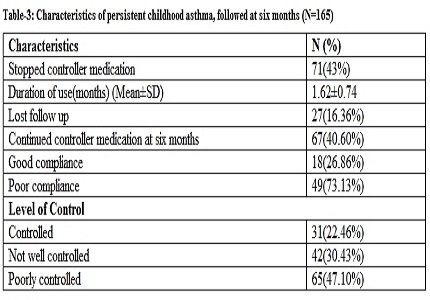Barriers in the management of childhood asthma: what care giver thinks about long term controller medication?
Abstract
Introduction: Asthma is the most common, chronic lower respiratory disease in childhood. Despite of the several guidelines and/or consensus documents available to support medical decisions to paediatric asthma; there are little updates available on the barriers’ to childhood asthma care among communities.
Objectives: We aimed to determine social barriers to the management of childhood asthma.
Methods: This was a qualitative, cross-sectional hospital based study in children aged between 1-15 years.
Results: total 423 children with asthma were recruited from July 2014 to July 2016.out of them 126(29.78%) had mild intermittent, 190(44.91%) had mild persistent, 73(17.25%) had moderate persistent and 32(7.56%) had severe persistent asthma. In all persistent asthma cases long term controller medication was prescribed in which only 186(62.62%) accepted long term controller, while 111(37.37%) patients did not. Reasons for non-acceptance of long term controller medication in new cases were of financial constraints 25(22.52%), fear of dependency of controller medication 23(20.72%),fear ofside effect 17(15.31%), social stigma of inhalational device 15(13.51%), more preference to cough syrup 31(27.97%).
Conclusion: A large numbers of barriers existed in the management of childhood asthma which has a bad impact on the patients and their families.
Downloads
References
2. Pearce N, Aït-Khaled N, Beasley R, Mallol J, Keil U, Mitchell E et al.; ISAAC Phase Three Study Group. Worldwide trends in the prevalence of asthma symptoms: phase III of the International Study of Asthma and Allergies in Childhood (ISAAC). Thorax. 2007 Sep;62(9):758-66. https://doi.org/10.1136/thx.2006.070169PMID:17504817.
3. Anderson HR, Gupta R, Strachan DP, Limb ES. 50 years of asthma: UK trends from 1955 to 2004. Thorax. 2007 Jan;62(1):85-90. [PubMed]
4. Toelle BG, Ng K, Belousova E, Salome CM, Peat JK, Marks GB. Prevalence of asthma and allergy in schoolchildren in Belmont, Australia: three cross sectional surveys over 20 years. BMJ. 2004 Feb;328(7436):386–7. https://doi.org/10.1136/bmj.328.7436.386.
5. Chhabra SK, Gupta CK, Chhabra P, Rajpal S. Prevalence of bronchial asthma in school children in Delhi. J Asthma. 1998;35(3):291-6. [PubMed]
6. Fuhlbrigge AL, Guilbert T, Spahn J, Peden D, Davis K. The influence of variation in type and pattern of symptoms on assessment in pediatric asthma.Pediatrics. 2006 Aug;118(2):619–25. https://doi.org/10.1542/peds.2005-2963. [PubMed]
7. Gustafsson PM, Watson L, Davis KJ, Rabe KF. Poor asthma control in children: evidence from epidemiological surveys and implications for clinical practice. Int J ClinPract. 2006 Mar;60(3):321–34. https://doi.org/10.1111/j.1368-5031.2006.00798.x.
8. Wildhaber J, Carroll WD, Brand PL. Global impact of asthma on children and adolescents’ daily lives: the room to breathe survey. PediatrPulmonol. 2012 Apr;47(4):346–57. https://doi.org/10.1002/ppul.21557. [PubMed]
9. Global Strategy for Asthma Management and Prevention. 2006. “The Global Initiative for Asthma 2006”.http://www.ginasthma.com/GuidelinesResources.aspaccessed 7 November 2007.
10. Shahady EJ. Letter to the editor on performance gap. JAMA. 2001;286:1834.
11. Crossing the Quality Chasm: A New Health System for the 21st Century.Institute of Medicine (US) Committee on Quality of Health Care in America. Washington (DC): National Academies Press (US); 2001. [PubMed]
12. Salvi SS, Apte KK, Dhar R, Shetty P, Faruqi RA, Thompson PJ, Guleria R.AsthmaInsights and Management in India: LessonsLearnt from the AsiaPacific - AsthmaInsights and Management (AP-AIM) Study. J Assoc Physicians India.2015 Sep;63(9):36-43. [PubMed]
13. Lal A, Kumar L, Malhotra S. Socio-economic burden of childhood asthma. Indian Pediatr. 1994 Apr;31(4):425–32. [PubMed]
14. Amy H.Y. Chan, Alistair W. Stewart, Juliet M. Foster, Edwin A. Mitchell, Carlos A. Camargo Jr, Jeff Harrison “Factors associated with medication adherence in school-aged children with asthma” ER J open research 2016 2: 000872015; DOI: https://doi.org/10.1183/23120541.00087-2015.
15. Gajanan G, Padbidri VS, Chaudhury A. Vinay Sandeep Padbidri, Alisha Chaudhury “Assessment of Knowledge and Attitude of Parents Towards the Allergy and Bronchial Asthma in Their Children”. Int J Med Public Health. 2016;6(3):121–5. https://doi.org/10.5530/ijmedph.2016.3.5.
16. Al-Jahdali HH, Al-Zahrani AI, Al-Otaibi ST, Hassan IS, Al-Moamary MS, Al-Duhaim AS et al. Perception of the role of inhaled corticosteroids and factors affecting compliance among asthmatic adult patients. Saudi Med J. 2007 Apr;28(4):569–73.
17. Vella C. GianlucaBezzina, Matthew Urpani “An audit of compliance of inhaled steroid medication in Maltese asthmatic children.”A comparison between 2008 and 2014. Malta Med J. 2014;26(02):25-28.
18. Zaraket R, Al-Tannir MA, Bin Abdulhak AA, Shatila A, Lababidi H. Parental perceptions and beliefs about childhood asthma: a cross-sectional study. Croat Med J. 2011 Oct;52(5):637–43. https://doi.org/10.3325/cmj.2011.52.637.
19. Global Initiative for asthma. Asthma management and prevention. NIH publication 1995; 96–3659A:19.
20. Ulrik CS, Backer V, Dirksen A. A 10 year follow up of 180 adults with bronchial asthma: factors important for the decline in lung function. Thorax. 1992 Jan;47(1):14–8. https://doi.org/10.1136/thx.47.1.14 PMID:1539138.
21. Djukanovic R. Airway remodelling: what is it? Asthma J. 1997;2:130–33.
22. NAEPP. National Asthma Education and Prevention Program. Expert Panel Report 2. Clinical Practice Guidelines: Guidelines for the Diagnosis and Management of Asthma. National Institutes of Health; National Heart, Lung, and Blood Institute. NIH Publication No. 98-4051; July 1997.

Copyright (c) 2017 Author (s). Published by Siddharth Health Research and Social Welfare Society

This work is licensed under a Creative Commons Attribution 4.0 International License.


 OAI - Open Archives Initiative
OAI - Open Archives Initiative


